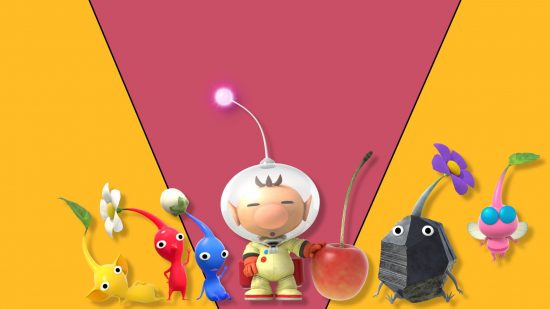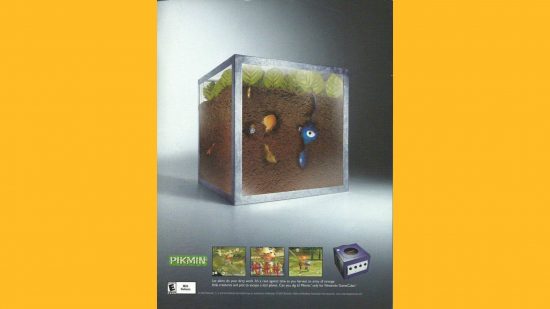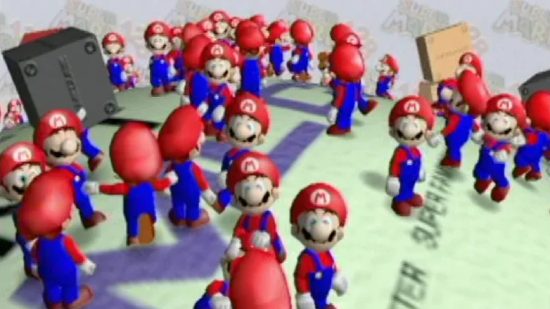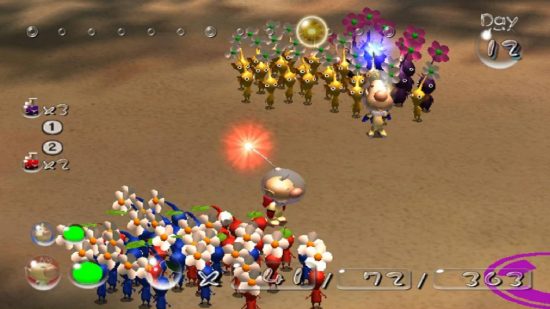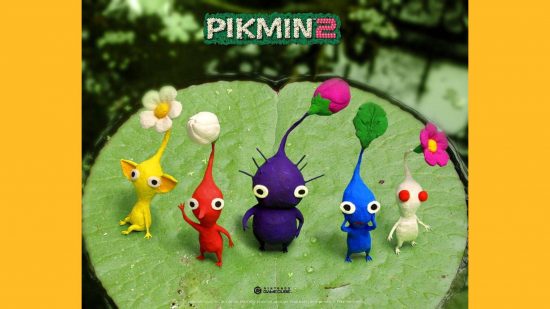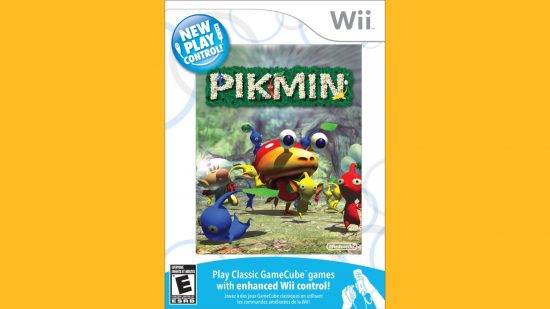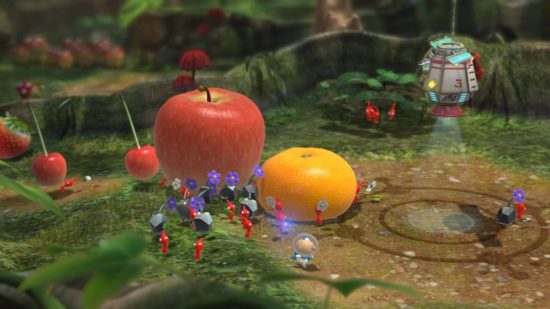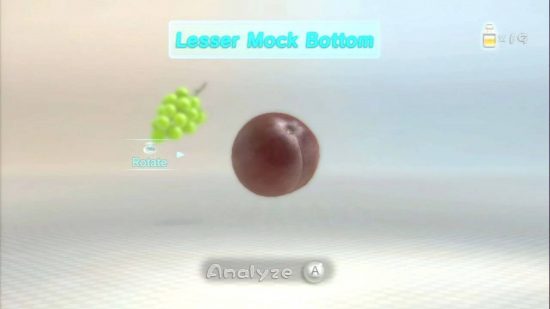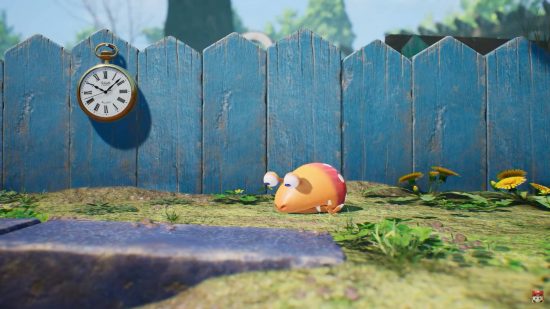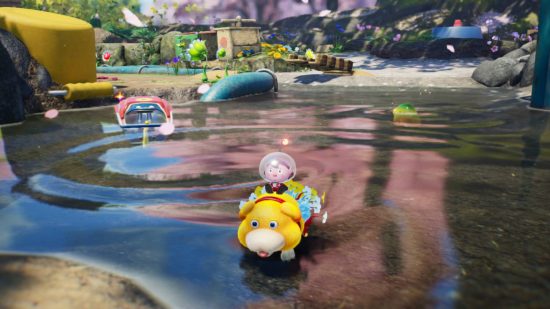Down at the bottom of the garden, with the birds and the bees, lives a bunch of tiny creatures… no, not the Poddington Peas (I might be showing my age there). Pikmin are a tiny species that are part animal and part vegetable, and they are absolutely adorable. They first appeared in the eponymous game Pikmin for the GameCube on October 26, 2001, and just recently Pikmin 4 heralded the series’ triumphant return on Nintendo Switch.
Alongside the pantheon of Nintendo legends like Mario, Zelda, Donkey Kong, and even Pokémon; many gamers consider the vegetable-like Pikmin somewhat underground (pun intended), a niche series with a fervent fanbase, but with little broad appeal. Well, today we’re going to look at the series’ over 20-year history and explore just why fans – and Nintendo themselves – still love pulling up those plucky Pikmin to this day.
If you didn’t already know, Pikmin is a first-party Nintendo series that mixes real-time strategy (RTS) elements with puzzles, as you command a small army of Pikmin to do your bidding. In the original Pikmin, you play as Captain Olimar after he crash lands on the planet PNF-404, with you, the player, searching for ship parts to reassemble his spaceship. However, he can’t do it alone, so he befriends the native and cute little Pikmin and commands them to collect and retrieve ship pieces as he explores the world like some sort of vegetable Pied Piper.
It’s not as simple as that though, as PNF-404 is full of wildlife that is very happy to gobble up those cute little Pikmin, and when night comes, things only get worse. So, Captain Olimar must race against the clock to complete tasks before nightfall. Not only that, but for Olimar, this alien planet boasts toxic air, so he must also manage to reassemble his ship in the required 30 days, or else he’ll fall victim to PNF-404’s poisonous atmosphere and suffocate.
If that all sounds a bit dramatic for a children’s game, you’d be right, but Pikmin is always straddling a line between cute and spooky, as those adorable Pikmin are often fodder for the ravenous creatures of their native planet. The sad “oOoOoOoOh” of a Pikmin spirit shuffling off its mortal coil is forever stuck in my brain, along with the unsettling sight of its poor little ghost rising up into the great beyond.
Adding to this macabre tone is the fact the original Pikmin has several endings depending on how you perform. If you manage to find all 30 ship pieces within the 30-day time limit, you get the good ending. You bag a normal ending by finding 25 ship pieces by day 30, but any less and you suffer through the bad ending, in which the protagonist Olimar dies. There are even plenty of both subtle and overt hints that the planet of PNF-404 is actually a post-apocalyptic Earth. Your mission in Pikmin 2 sees you picking up plenty of artifacts from our planet, including actual branded items such as Duracell batteries, Skippy peanut butter, and even a Snapple bottle cap.
These unsettling undertones become even more interesting when you learn where the original concept of Pikmin came from. Back in August of 2000, Nintendo hosted its annual Nintendo Space World conference in Japan. To drum up excitement for the power of the GameCube, Shigeru Miyamoto appeared on stage and revealed a demo for Mario 128 to the audience. This tech demo showed 128 models of Mario, all moving around a spherical level and each performing tasks such as moving boxes.
While it’s clear some of these concepts later evolved into Super Mario Galaxy, it seems the idea of controlling many characters at once is what birthed the concept for Pikmin. Many years later in 2007, Miyamoto appeared at GDC to give a keynote speech, and commented: “The one question I’m always asked is, ‘What happened to Mario 128?’ … Most of you already played it … in a game called Pikmin”
Upon its release, Pikmin on the Nintendo GameCube performed well critically, with its visuals providing a great showcase for Nintendo’s console. This led to Nintendo moving swiftly onto the development of Pikmin 2, which the developer released in 2004, also for the Nintendo GameCube. This sequel managed to address a few criticisms of the original title, as Pikmin 2 does away with the time limit, allowing players to explore as they please, and making the game much longer in the process.
Pikmin 2 also introduces caves, many more Pikmin, and even a multiplayer mode, greatly expanding the Pikmin series in the process. While the original only had the red, blue, and yellow Pikmin, the sequel introduces purple and white Pikmin, as well as the parasitic Bulbmin which you can only use in caves. While the new purple Pikmin are more powerful, the little white pals are small and can resist poison, adding even more fun wrinkles for puzzles.
Set straight after the events of Pikmin 1, Captain Olimar returns to his home planet only to find out the company he works for is in huge debt. However, one of the PikPik carrots he brought back is worth a huge chunk of change. So, Olimar’s boss tasks him and his new sidekick Louie to head back to PNF-404 to find other trinkets and treasures in hopes of paying off their debt.
Much like its predecessor, Pikmin 2 was very well received. In fact, many scored it higher than the original, noting that the omission of a time limit and the new Pikmin greatly improved the length and variation of the game. So, full steam ahead on Pikmin 3 surely? Well, not quite. What follows is a strange period for Pikmin, as while they are certainly some new steps for the franchise, it would be quite some time before a new entry finally surfaced.
In the intervening years before Pikmin 3, Masahiro Sakurai added Olimar to Super Smash Bros Brawl, with the captain plucking Pikmin from the ground and using them to attack Mario and pals. There’s also the New Play Control! releases of Pikmin and Pikmin 2 for Nintendo Wii. These releases boast widescreen support, some slight changes to gameplay (you can now save on individual days in Pikmin), and of course, support for the Wii controller. Some players complained of difficulty with controls on the GameCube releases, but the Wii controller offers a level of precision similar to a computer mouse, as players use the pointer to control the Pikmin instead of an analog stick.
Sadly, the Wii never got its own Pikmin release, but instead, Nintendo moved development of the threequel onto its next console, the Wii U. Luckily, this move brought with it the addition of HD visuals, and provided eager fans with a new entry that lived up to huge fan expectations. Pikmin 3 tasks the player with controlling three different captains at once, as space explorers Charlie, Brittany, and Alph travel from the planet Koppai, in a desperate search for resources. They must search PNF-404 for fruit, in the hopes of taking it home to save their planet and species.
Nintendo released Pikmin 3 on the Wii U in 2013, and this third entry introduces even more new Pikmin to the mix, as Rock Pikmin and Winged Pikmin join the fray. Rock Pikmin act much like the muscle, as you can throw them to attack large enemies and smash breakable barriers. Meanwhile, winged Pikmin can pick up items and take them back to your spaceship over any terrain, with no worry about drowning in water.
The third entry also boasted a fun two-player mode called bingo battle, where you and a friend race to gather items to fill a bingo sheet, using your best Pikmin commanding skills to be the first to cross out a line and call bingo. Pikmin 3 even got plenty of DLC, with new levels added after release. Critics and fans alike praised Pikmin 3, with its move to HD visuals working wonders for the foliage-filled series, as Nintendo packed its small levels with such dense visual detail., The in-game fruit even became something of a meme, thanks to each item’s mouth-watering visual clarity.
Perhaps if it hadn’t been for the failure of the Wii U, a Pikmin 4 might have happened much sooner, as Miyamoto himself revealed the development of a new entry in an interview with Eurogamer a few years later. Miyamoto spoke to Eurogamer editor-in-chief (then news editor) Tom Philips in 2015, and when asked about a new Pikmin entry said “It’s actually very close to completion, Pikmin teams are always working on the next one.” Well, reader, I’m sure you can tell that something clearly didn’t line up.
The next few years are another strange bunch, as Nintendo released the 2D side scroller Hey! Pikmin for the Nintendo 3DS in 2017. Stripping away many beloved elements from the series, Hey! Pikmin’s greatest sin is just being…fine. It doesn’t feel much like a Pikmin game with its simplistic level design and gameplay, and yet it doesn’t do enough as a platformer to be good in its own right. It goes down as one of the most forgetful moments in the Pikmin series’ history, and for a long time, fans were anxious that this was the aforementioned “Pikmin 4” Miyamoto had been speaking about. Nintendo did confirm afterward that Hey! Pikmin was not Pikmin 4, so we were once again playing the waiting game.
2020 offered a glimmer of hope to Pikmin fans, as while the elusive Pikmin 4 didn’t quite make an appearance, Pikmin 3 Deluxe joined the long list of Wii U games moved over to the widely popular Nintendo Switch, helping to gather some sales from sunk development costs. This new port added new control options such as the ability to use a Joy-Con much like a Wii controller pointer, while also including all the previous DLC, new missions featuring Olimar, and a cooperative mode for the main campaign. In short, it’s by far the best way to play what might be the best entry in the series, and Nintendo was likely banking on it reinvigorating the dormant Pikmin fanbase.
After a long, long wait: Nintendo finally revealed Pikmin 4 to the world on September 13, 2022, nearly a decade after Pikmin 3. While fans waited for more details and its eventual release in 2023, Nintendo did sprinkle some Pikmin love elsewhere as the adorable vegetables are visible both in the Super Nintendo World parks in Universal Studios Japan and Hollywood, but there’s even a blink-and-you’ll-miss-it cameo from a Pikmin-shaped vase in The Super Mario Bros Movie. It’s clear that whether a game is ever in active development or not, plenty of staff over at Nintendo Towers hold a soft spot for this series.
Now, we reach the summer of 2023, and what I like to call the Summer of Pikmin. Nintendo held a Nintendo Direct presentation on June 21, 2023, finally lifting the lid on many of Pikmin 4’s details, as well as unveiling ports of Pikmin 1 (genuinely, they changed the name to Pikmin 1 and it irks me) and Pikmin 2 for the Nintendo Switch. Alongside Pikmin 4, this means you can buy every mainline entry for the Nintendo Switch, an accomplishment that neither Mario nor Zelda can boast. However, Pikmin does have considerably fewer entries to worry about.
Nintendo finally released Pikmin 4 on July 21, 2023, to wide critical acclaim. The latest entry in the series lets you create a player character, as you explore a remote planet in a bid to rescue several lost crew members of a team called the Rescue Corps. Much like before, you control a multitude of Pikmin to find and retrieve items, but this time you also have the help of a dog-like creature called Oatchi, which you can ride, command, and teach several new skills to help you explore this strange new world.
I’m not going to talk much more about Pikmin 4, as you should explore it for yourself, but it’s a fantastic way to reset the series for newcomers while providing fun nods to previous entries that fans can appreciate. It also streamlines many of the series’ management processes, while offering up new types of challenges, levels to explore, and even new Dandori battles where you work against a timer to retrieve as many items as possible to beat your opponent.
While fans love the Pikmin series, its more involved style of gameplay and quirky characters mean that it might not have the mainstream appeal that makes characters like Mario quite so ubiquitous But the Pikmin fanbase is strong, and it’s only growing as Nintendo continues in its efforts not only to preserve previous entries, but keep the torch alive with new entries. Even if they do take a decade to arrive, it’s clear Miyamoto and many other Nintendo staff are always going to be pushing to create the next iteration of the Pikmin franchise, and they are sure to only do it when they have new and exciting ideas that will add to the series, instead of letting it get stale.
Upon the eventual release of Pikmin 4, Eurogamer editor-in-chief Tom Philips reviewed the title, in a wonderful full-circle moment as his prophetic article from 2015 finally came to fruition. We asked Tom Phillips to comment on the eventual release of Pikmin 4, and he replied: “To me, Pikmin has always been a secret I’ve been bursting to share. It’s a brilliant little series that has been overlooked for too long – and for a while, I wasn’t sure it would even get a chance to continue. That’s why I had to ask Shigeru Miyamoto about it when I first interviewed him, and why that long-held promise of Pikmin 4 being in development was such a joy to finally see come to fruition. Being able to review it and realize it wasn’t just another great Pikmin game but – in my eyes – the best in the series was the icing on the cake.”

Pikmin 4 is still fresh in many fan’s minds, and alongside the Switch ports of Pikmin 1, 2, and Pikmin 3 Deluxe, there has truly never been a better time to get into this quirky, slightly creepy, and immensely satisfying series. If Miyamoto himself adores it this much, it must be good, so let’s hope we’re not waiting another decade for Pikmin 5.
For more content like this, make sure you check our Pikmin 4 review and Pikmin 1+2 review, then head over to our guide on the best new Switch games of this year.
